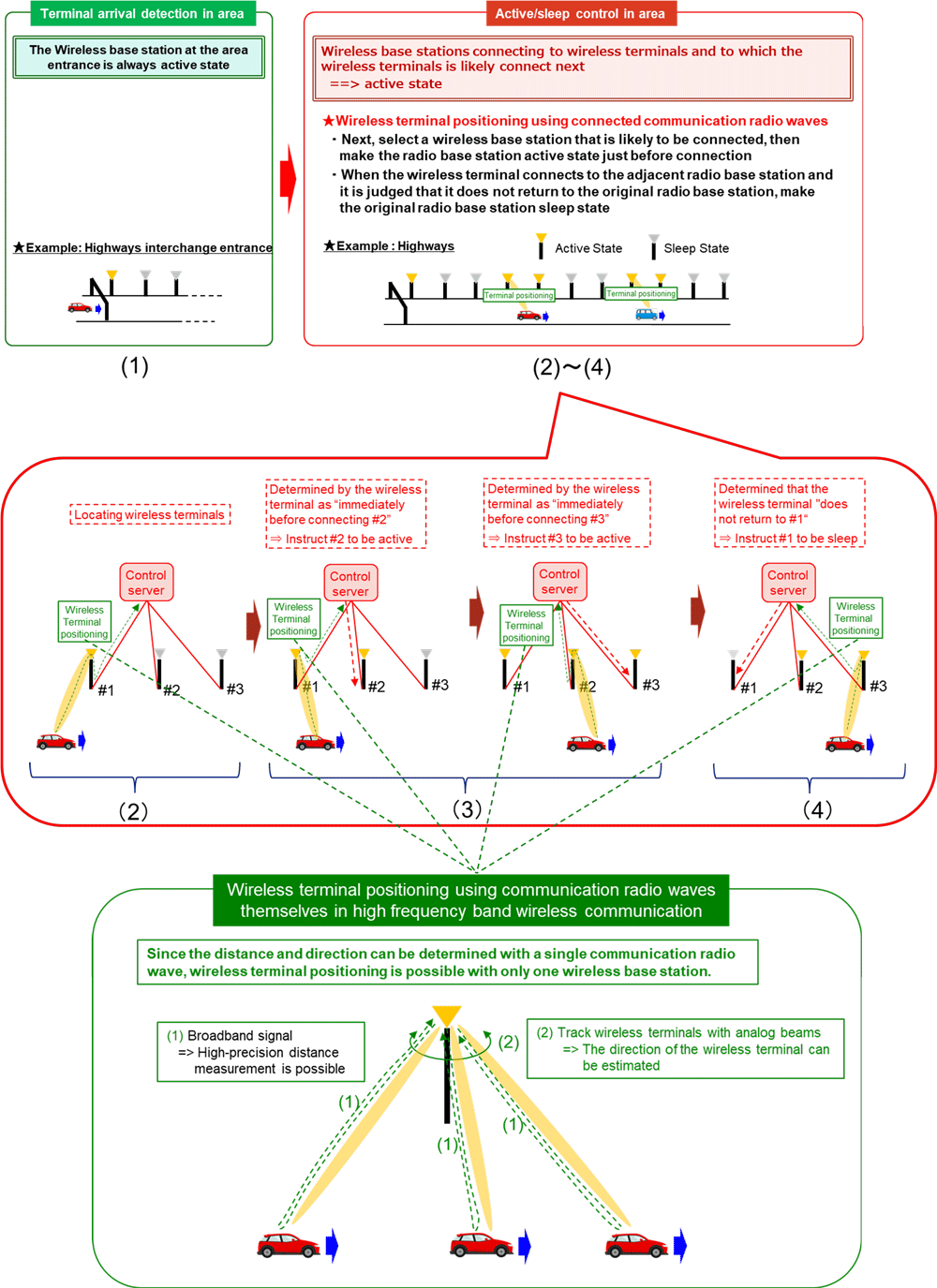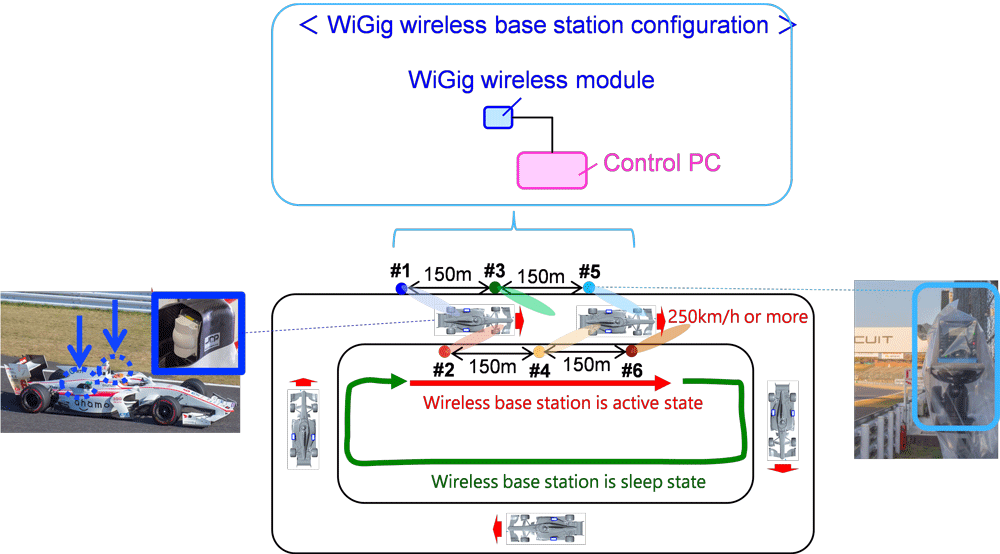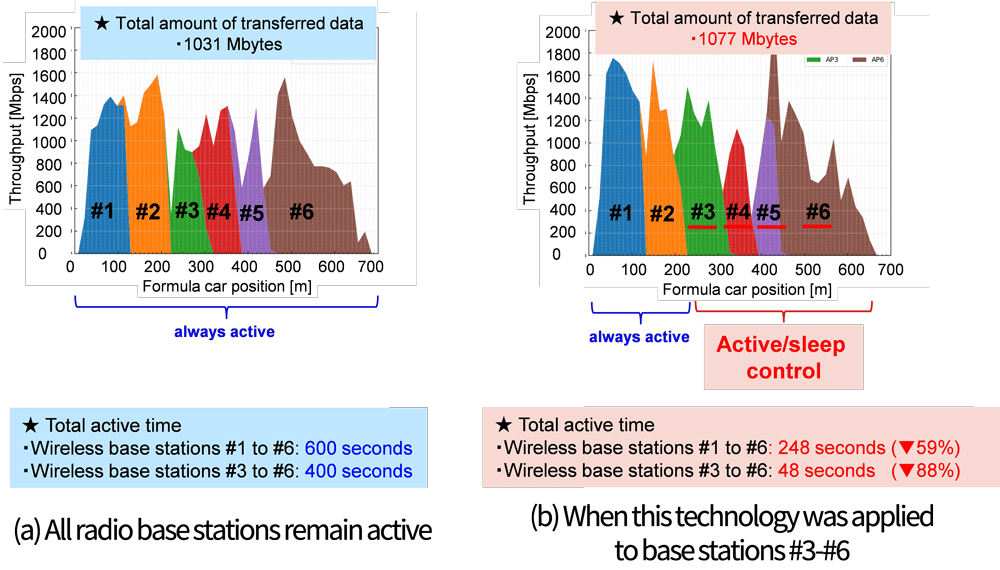Microsoft ends support for Internet Explorer on June 16, 2022.
We recommend using one of the browsers listed below.
- Microsoft Edge(Latest version)
- Mozilla Firefox(Latest version)
- Google Chrome(Latest version)
- Apple Safari(Latest version)
Please contact your browser provider for download and installation instructions.
March 31, 2023
The world's first realization of wireless base stations with lower power consumption based on positioning information by using communication radio waves
Contributing to carbon-neutrality for high-speed and high-capacity mobile communications
Tokyo – March 31, 2023 – NTT Corporation (TYO:9432), today announced that it has verified intermittent operation control technology for wireless base stations based on wireless terminal positioning using communication radio waves for the first time in the world*1, by using a 60 GHz band wireless LAN (WiGig*2) and a formula car with a maximum speed of at least 250 km/h. This technology makes it possible to switch wireless base stations between their active and sleep states*3, depending on whether wireless terminals are expected to be connected or not. As a result, in use cases such as highways and railways, where wireless terminal connection to wireless base stations changes regularly depending on the time of day and location, it is possible to maintain high-capacity wireless transmission while reducing the power consumption of the wireless base stations.
1. Research background
High-frequency bands such as millimeter waves and sub-terahertz waves are expected to be used to realize even higher speed and larger capacity wireless communication toward 5G and 6G. In addition, reducing the power consumption of networks is an important issue for the realization of a sustainable society that well addresses global environmental issues *4. If wireless communications use high frequency bands, the coverage area of a single wireless base station is smaller than that with low frequency bands. Therefore, depending on the distribution of wireless terminals, there may be wireless base stations that are not currently connected to wireless terminals. By switching such wireless base stations from the active state to sleep state, the power consumption of some wireless base stations can be reduced, contributing to lower power consumption of the entire network.
Examples of such intended use cases are highways and railways. When wireless base stations using a high-frequency band are densely deployed along roads or railroad tracks, if the number of cars and trains targeted by wireless terminals is sparse, there will be many wireless base stations that are not currently connected to wireless terminals. If it is possible to adaptively switch those wireless base stations from active state to sleep state according to anticipated timing of cars and trains; this is expected to reduce the power consumption of the entire wireless system (Fig. 1). Intermittent operation control (switching between active state and sleep state) of wireless base stations has been suggested, but only for relatively long fixed time periods, and highly flexible (and thus very efficient) control has not been realized up to now.
 Figure.1 Outline of intermittent operation control of wireless base stations serving highways, railways, etc
Figure.1 Outline of intermittent operation control of wireless base stations serving highways, railways, etc
2. Technology overview
To address these issues, NTT focused on two key attributes of high-frequency wireless communications, strong antenna directivity*5 and signal broad bandwidth*6, and devised the world's first intermittent operation control method that uses the communication radio waves themselves to predict wireless terminal positions. Concretely, the following method is used to switch each wireless base station between the active state and sleep state (Fig. 2).
- If the target area, such as a highway or railroad, is closed, the wireless base station at the entrance to that area remains active. The other wireless base stations are kept in sleep state.
- When a wireless terminal is connected to a wireless base station, the wireless terminal positioning is estimated using the connected communication radio wave.
- If the positioning information determined by the entrance base station indicates that a wireless terminal is likely to enter the cover area of an adjacent wireless base station, that wireless base is switched from sleep state to active state.
- When the wireless terminal moves and connects to the next wireless base station, wireless terminal movement is estimated from the history of the communication radio waves and the characteristics of the target area. Based on the estimated movement, if it is determined that the wireless terminal is unlikely to return to the cover area of the previous wireless base station, that station is switched from the active state to the sleep state.
This technology makes it possible to flexibly operate wireless base stations intermittently according to the movement timing of vehicles, trains, etc.
 Figure.2 Intermittent operation control technology for wireless base stations based on wireless terminal positioning using communication radio waves
Figure.2 Intermittent operation control technology for wireless base stations based on wireless terminal positioning using communication radio waves
3. Experimental Overview
3-1. Demonstration Details
The experiment demonstrating this technology used a 60 GHz band wireless LAN (WiGig) as an example of a high-frequency band wireless communication system that enables terminal positioning to be realized by using communication waves. The experiment was conducted at the "All Japan Super Formula Championship Joint Test Rookie Test" held at Suzuka Circuit from December 7th (Tuesday) to 8th (Wednesday), 2022. This experiment was supported by the racing team "DOCOMO TEAM DANDELION" that provided and operated a formula car that can reproduce the ultra-high-speed mobile environment of "RACING". The experiment was also supported by NTT DoCoMo Co., Ltd. and DoCoMo Technology Co. Ltd. who constructed an area for the ultra-high-speed mobile experiments and cooperated by developing techniques for mounting mobile terminals on high-speed vehicles.
WiGig wireless terminals were installed on both side pods of the formula car, and three WiGig wireless base stations are installed on each side of the main straight course, which offers the maximum speeds on the track (formula cars travel at speeds of 250 km/h or more*7) (Fig. 3). The wireless base station switching and terminal-driven site diversity technologies*8*9 tested in 2020 and 2021 were also applied in this experiment. Wireless base stations #1 and #2 are regarded as the wireless base stations at the entrance of the area and so were always active; the intermittent operation control technology was applied to wireless base stations #3 to #6. The intermittent operation of the WiGig wireless base stations were simulated as active and sleep states by transmitting/stopping beacon signals*10. The WiGig wireless base station used in this demonstration experiment consisted of a WiGig wireless module and a control PC, and consumed 25W and 15W in the active state and sleep state, respectively. In addition, this experiment was conducted using only one formula car to verify the technology's ability to follow wireless terminal mobility and appropriately realize wireless base station switching between the active state and the sleep state.
The total active periods of base stations #1 to #6 and base stations #3 to #6 were measured as the formula car lapped the circuit. Moreover, we measured the total amount of data transferred at layer 2 from WiGig wireless terminals and all WiGig wireless base stations for each lap. By these measurements, we simultaneously evaluated the wireless transmission performance and the reduction in power consumption when this technology was applied.
 Figure. 3 Experimental system for demonstration experiment
Figure. 3 Experimental system for demonstration experiment
3-2. Results
Figures 4(a) and 4(b) show, for 6 laps of the circuit, the measured values of the total amount of transferred data and the total active time when this technology was not applied (base stations #1 to #6 are always active state) and when it was applied, respectively. The total amount of transferred data was 1031 Mbytes in case (a) and 1077 Mbytes in case (b). Regarding the total active time of wireless base stations, base stations #1 to #6, was 600 seconds and base stations #3 to #6 was 400 seconds in case (a) ; each lap of the circuit by formula car took 100 seconds. With our technology active, case (b), we were able to confirm that the active periods were greatly reduced to 248 seconds (all base stations) and 48 seconds for base stations #3 to #6. As a result, the power consumption per second of each WiGig wireless base station used this demonstration experiment was reduced by 150Ws ⇒ 114.8Ws for wireless base stations #1 to #6, and by 100Ws ⇒ 64.8Ws for wireless base stations #2 to #5.
 Figure.4 Experimental results (total transfer data amount and total active time of wireless base stations)
Figure.4 Experimental results (total transfer data amount and total active time of wireless base stations)
4. the Next step
Since this technology utilizes wireless terminal positioning made possible by using communication radio waves, it can be deployed in indoor areas if high-precision wireless terminal positioning can be achieved. For example, this technology is expected to suit areas where terminals are few at certain times of the day, such as shopping malls outside business hours, and areas where the presence distribution of wireless terminals is spatially uneven, such as line operations in factories.
This technology utilizes the features of high-frequency band communication radio waves to determining the movements of wireless terminals, and is seen as supporting not only to WiGig but also to other high-frequency band wireless communication systems. We will study the application of this technology to millimeter wave and terahertz wave band wireless transmission systems that are expected to be used in the future eras of 5G and 6G. Moreover, we will estimate the power consumption of wireless base stations in active state / sleep state and during switching between states, and study the overall reduction of power consumption with consideration of the switching frequency. Furthermore, we will promote technical studies to achieve both stable wireless transmission and low power consumption in various usage environments.
*1: As of March 10, 2023, according to NTT research
*2: Abbreviation for Wireless Gigabit. Wireless LAN standard using 60 GHz band based on IEEE 802.11ad standard
*3: The active state is the normal state in which the wireless base station is transmitting and receiving, and the sleep state is the state in which power consumption is kept to the minimum necessary without transmitting or receiving.
*4: New environmental energy vision "NTT Green Innovation toward 2040" (September 28th, 2021)
https://group.ntt/en/newsrelease/2021/09/28/210928a.html
*5: An antenna that focuses radio waves in a specific direction. Radio waves are also strongly received in this direction.
*6: Wide signal bandwidth. The number of symbols that can be transmitted per second increases, the time resolution increases, and the ranging accuracy increases.
*7: Driving speed record of the formula car used in the experiment
*8: Actual proof of control technology for switching base stations using positioning information derived from communication radio waves for the first time in the world -Realizing wireless broad band transmission in the 60 GHz band to a formula car running at 300 km/h- (February 3rd, 2021)
https://group.ntt/en/newsrelease/2021/02/03/210203a.html
*9: The world's first uninterrupted large-capacity wireless transmission in a high-speed mobile environment using 60GHz band wireless communication originally static wireless communication such as millimeter -wave band wireless LAN is applied to mobile objects such as cars- (February 25th, 2022)
https://group.ntt/en/newsrelease/2022/02/25/220225a.html
*10: A broadcast signal used by a wireless base station to notify wireless terminals of its presence. A wireless base station periodically sends this signal. After a wireless terminal receives this signal, it can connect to the wireless base station.
Contact Information
NTT Information Network Laboratory Group
Planning Department, Public Relations Section
nttrd-pr@ml.ntt.com
Information is current as of the date of issue of the individual press release.
Please be advised that information may be outdated after that point.
NTT STORY
WEB media that thinks about the future with NTT









